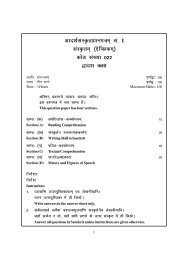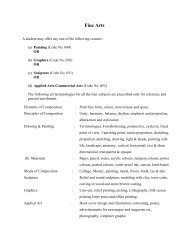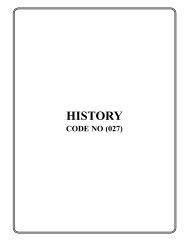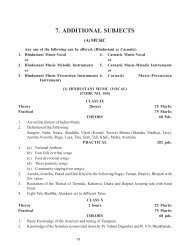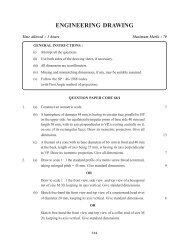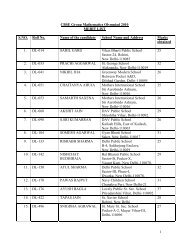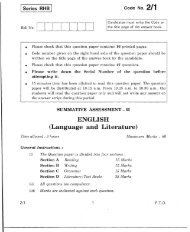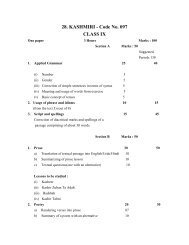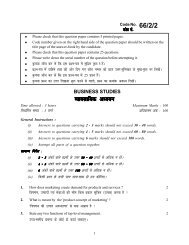A Text Book on Engineering Graphics - Central Board of Secondary ...
A Text Book on Engineering Graphics - Central Board of Secondary ...
A Text Book on Engineering Graphics - Central Board of Secondary ...
Create successful ePaper yourself
Turn your PDF publications into a flip-book with our unique Google optimized e-Paper software.
USE OF COTTER JOINT<br />
The joint is useful in the following c<strong>on</strong>diti<strong>on</strong>s:<br />
USE OF TAPER IN COTTER JOINT:<br />
110<br />
ROD JOINTS<br />
(i) To c<strong>on</strong>nect a rod directly with a machine, so as to transmit a force to the machine<br />
through the rod or vice- versa.<br />
(ii) When it is desired to increase the length <strong>of</strong> the rod.<br />
(iii) To c<strong>on</strong>nect two rods rigidly in the directi<strong>on</strong> <strong>of</strong> their length.<br />
The taper in the cotter is provided to take the advantage <strong>of</strong> wedging acti<strong>on</strong> (fricti<strong>on</strong> locking). The<br />
taper also keeps the joint alive even after some wear in the joint has taken place as the gap<br />
generated due to the wear automatically filled up by the self travel <strong>of</strong> the cotter. This travel is<br />
assisted due to the taper given in the cotter. Taper helps in inserti<strong>on</strong> into the positi<strong>on</strong> and<br />
withdrawal and lateral adjustment <strong>of</strong> c<strong>on</strong>nected parts. The taper should not be too large causing<br />
self removal <strong>of</strong> the cotter under the external load, but if the large taper is essential, in a case<br />
when frequent disassembly is required, locking devices such as set screw/lock pin etc. become<br />
necessary to secure the cotter in positi<strong>on</strong> against the slackening or removal <strong>of</strong> the cotter from its<br />
positi<strong>on</strong>. Generally, the taper <strong>of</strong> 1: 30 is given and is decided <strong>on</strong> the basis <strong>of</strong> the angle <strong>of</strong> fricti<strong>on</strong><br />
between cotter and rods material. The taper angle should not be greater than the angle <strong>of</strong><br />
fricti<strong>on</strong>. The thickness <strong>of</strong> the cotter is generally kept equal to <strong>on</strong>e fourth and <strong>on</strong>e fifth <strong>of</strong> its width<br />
in the centre. The width <strong>of</strong> the slot is made 3 to 5 mm bigger than the cotter. When the cotter fits<br />
into the slot, the central porti<strong>on</strong> <strong>of</strong> the cotter comes in c<strong>on</strong>tact with spigot and pushes it into the<br />
socket. These forces <strong>on</strong> the c<strong>on</strong>tacting surfaces prestress the joint and provide the required force<br />
for fricti<strong>on</strong> locking <strong>of</strong> the bearing surfaces. Finally, the edges <strong>of</strong> the cotter and the edges <strong>of</strong> the<br />
slot are rounded.<br />
In our syllabus the assembly and disassembly <strong>of</strong> cotter joints for circular and square rod are there.<br />
We shall learn that there are three cotter joints for c<strong>on</strong>necting the circular rods:<br />
a. Sleeve and Cotter joint<br />
b. Socket and Spigot joint and<br />
c. Knuckle joint (<strong>on</strong>ly secti<strong>on</strong>al fr<strong>on</strong>t view is in our syllabus).<br />
Also in our syllabus there is <strong>on</strong>ly <strong>on</strong>e cotter joint for joining square or rectangular rods and<br />
it is called:<br />
d. Gib and cotter joint.<br />
Now, let us learn more about the Sleeve and Cotter Joint<br />
ENGINEERING GRAPHICS



